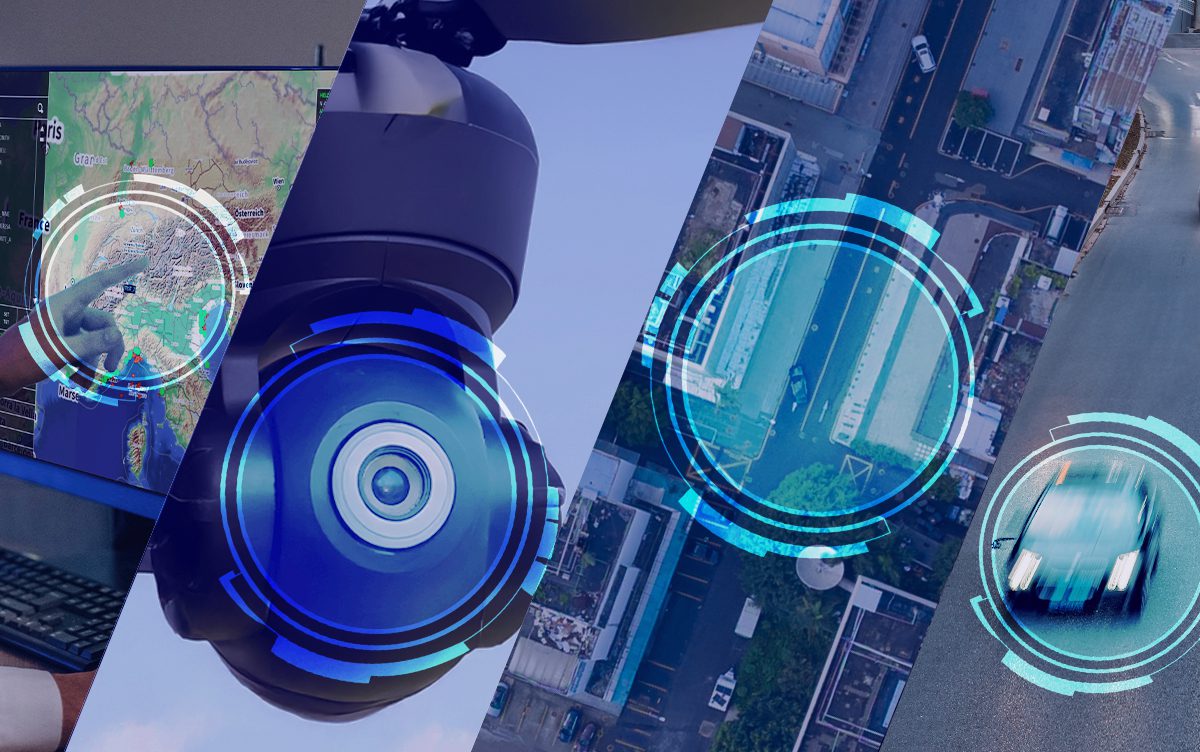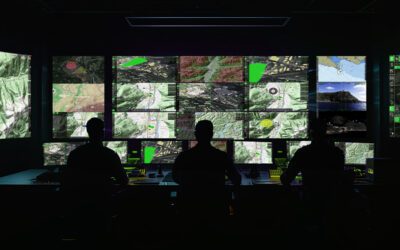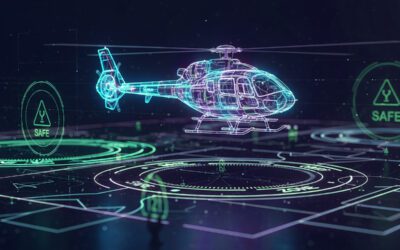Intelligence, surveillance, target acquisition and reconnaissance are the four pillars of both military and police operations. Shortened to ISR, they play a vital role in police aviation and airborne operations. As technology advances, ISR in law enforcement yields increasingly improved results, which, in turn, encourages police aviation departments to incorporate ISR philosophies into their operations to a greater degree.
In this article, we’ll take a look at how intelligence surveillance and reconnaissance in policing is being enhanced by the introduction of advanced technology such as AI, multi-spectral sensors and Enhanced Reality. We’ll examine how ISR can benefit law enforcement operations and look at how it’s currently being deployed, as well as its future applications. We’ll also introduce the innovative FlySight’s OPENSIGHT, which represents the cutting edge of ISR technology.
What is ISTR?
Intelligence, surveillance, target acquisition, and reconnaissance may seem independent of one another, but in the context of a police aviation operation, they are intrinsically interconnected. To bring all the strands together, technology previously developed for the military is increasingly being utilised, particularly in aerial platforms such as helicopters. The primary reason for this is that the technology is now small enough to be integrated into existing systems, thereby enhancing operators’ abilities to conduct ongoing, real-time observations and data collection.
Traditionally, ISR was used in military operations to gather crucial data on the location of hostile combatants in challenging theatres. That data could then be relayed back to a command centre, where it could be analysed and form the basis for further operations. It’s not hard to see how military-based ISR techniques have transferred easily over to police aviation.
For ISR to be useful, it has to be accurate. It also has to be up-to-date. Whereas traditional ISR in law enforcement relied on passive monitoring, modern ISR in policing uses real-time intelligence gathering and target identification, often from airborne platforms including helicopters and unmanned drones. The scope of ISR makes it the foundation of modern law enforcement aviation worldwide.
The technology used for ISR in law enforcement is wide-ranging. It can include:
- Advanced, multi-spectral sensors including high-definition EO/IR cameras with enhanced zoom and stabilisation capabilities, as well as the ability to see through haze or fog
- Persistent surveillance through the use of tethered or long-endurance UAVs
- Data integration and AI for faster data analysis and enhanced target recognition, as well as data collation and real-time analysis
- Sensor integration, where multiple sensors are combined into a single system
- Augmented or Enhanced Reality programs, which introduce additional data into a surveillance operation in real-time, providing airborne crews with essential background information
The shift towards ISR in law enforcement
While the advantages of ISR in military operations have been recognised for a while, the technology is now also finding a place in police aviation. The significant advantages include the fact that ISR consoles can be easily integrated into existing cockpit hardware without occupying additional space. They are also intuitive to use, reducing training time and enabling operators to make the most of every minute in the air.
A ‘joined-up’ approach to intelligence, surveillance, and reconnaissance also helps law enforcement keep up with increasingly technologically advanced targets. The ability to connect to a control centre and exchange information in real-time also means that the parameters of a surveillance or target acquisition operation can be changed instantly to respond to fluid situations. That allows ISR technology to be used in more difficult operations such as disaster SAR, crowd control or civil unrest.
Integrating ISR into aerial policing practices
The various aspects of intelligence, surveillance, target acquisition, and reconnaissance integrate into standard law enforcement aviation practices, offering numerous benefits. It can improve real-time monitoring, as already discussed, and also elevate response times, keeping operators safer, especially in difficult flying conditions. For example, FlySight’s OPENSIGHT Mission Console can includes software that improves visibility in hazy conditions – ideal if a disturbance on the ground is obscured by smoke or foggy conditions.
The increased use of data in all aspects of policing technology fits well with ISR consoles, providing interoperability between existing hardware and new software systems. That means data collected by an aerial platform can be integrated with passive data from body cams, CCTV, and drones, creating a multi-layered picture.
ISR in law enforcement
ISR practices in police aviation are also becoming more advanced as each new generation of technology emerges. For example, improved live drone feeds and aerial reconnaissance capabilities make it easier to adapt an operation to changing circumstances, as well as identify targets in complex situations, such as urban settings.
ISR technology, using software such as AI-enabled video analytics, can eliminate background ‘noise’ through a faster analysis of the data. This is crucial for real-time threat detection, integration with dispatch and command centres for enhanced team communication, and significantly improved response and detection rates in search and rescue missions.
ISR effectively transforms an aerial platform, such as a helicopter, into an intelligence hub. It can be deployed in a wide range of different scenarios where police aerial teams are involved:
- Crowd control and public order – Large-scale protests can be extremely fluid situations. Helicopters equipped with EO/IR sensors can collect real-time surveillance, which can then be relayed to ground units for rapid deployment and response.
- High-speed pursuits – helicopters are often used in police pursuits to minimise the risk to the public and ground-based crews. Even at night, ISR police technology, such as infrared cameras and high-resolution spectral sensors, can identify, track, and guide ground units to the location of the target vehicle.
- Intelligence gathering and Reconnaissance – Discreet data collection and post-mission analysis is possible using the latest advanced ISR, such as video management systems, integrated sensor systems and high-tech cameras.
- Search & Rescue – Not all scenarios are surveillance operations. During a SAR situation, integrated sensors and ISR technology can be utilised in locating potential victims in a disaster zone. Overlaying Enhanced Reality data, such as a map, can help to identify a location that has been devastated by a wildfire, flood or earthquake, for example.
The challenges of introducing ISR in law enforcement organisations
While there are numerous advantages to incorporating ISR into police aviation, there are also some challenges. The most controversial aspect of the use of ISR is the issues surrounding data privacy and the morality of surveilling a population without their knowledge or consent. Data privacy issues are protected by law through the Data Protection Act in the UK and similar legislation in other countries. But convincing the public that ISR is being used responsibly and for the correct reasons may take a little more time.
Other issues include potential problems with integrating the latest technology with legacy systems, especially in an aerial platform, where the cost of a complete refit can be prohibitively expensive. To overcome this issue, systems such as the FlySight OPENSIGHT Mission console have been specially designed to easily integrate with existing hardware, making them user-friendly and intuitive, which in turn reduces the cost and timescale of operator training.
The future of ISR in policing – what’s the potential?
ISR in law enforcement aviation has a great future. Its benefits are already being felt, making operational time in the air far more productive, while also providing an additional layer of safety for operators both on the ground and in the air.
However, its potential is far-reaching, with concepts such as predictive policing and increased collaboration between emergency services teams having the potential to save lives. This, in turn, could result in reduced crime rates in ‘hot spots’, as well as more proactive responses to rapidly changing situations, such as public unrest or a major emergency.
The use of cloud storage for data is also a key part of the application of ISR – the ability to share information in real-time to command centres or ground units produces a far more joined-up operation that can respond instantly to any additional information the aerial unit can provide. As connectivity speeds increase, that ability will improve exponentially.
FlySight OPENSIGHT Mission Console for police aviation
The future of ISR is already here, with the development of FlySight’s OPENSIGHT Mission Console. Packed with features including video analytics, threat detection, and mission coordination, as well as unique plug-ins such as NATO STANAG 4607 Ground Target Tracking Enhancement, High-Performance Video Processing, and the incorporation of Real-time Enhanced Reality data, OPENSIGHT puts police aviation teams at a distinct advantage.
Find out more by watching our informative videos, or get in touch today to find out more about the OPENSIGHT Mission Console solution for police aviation and public safety missions.




